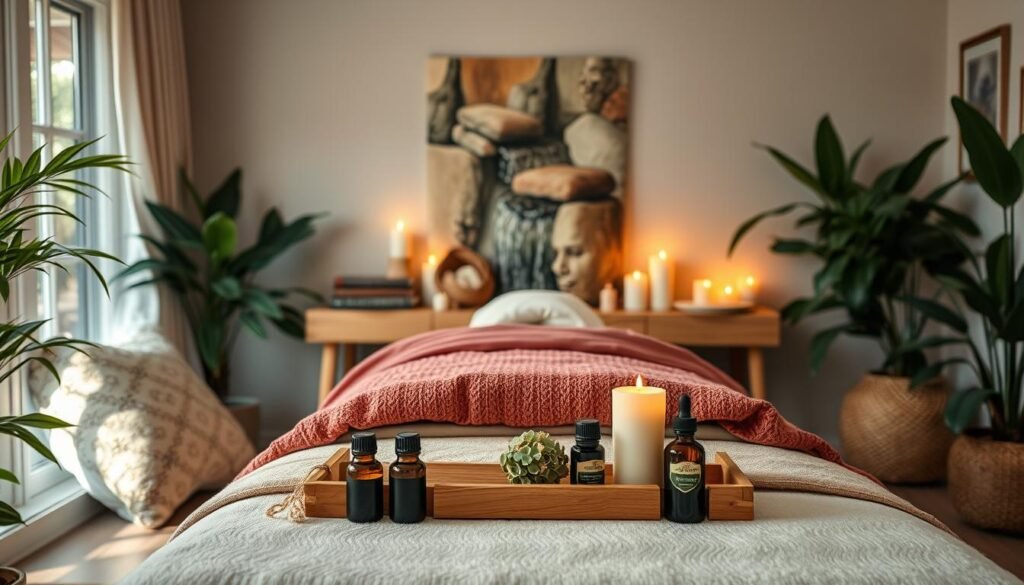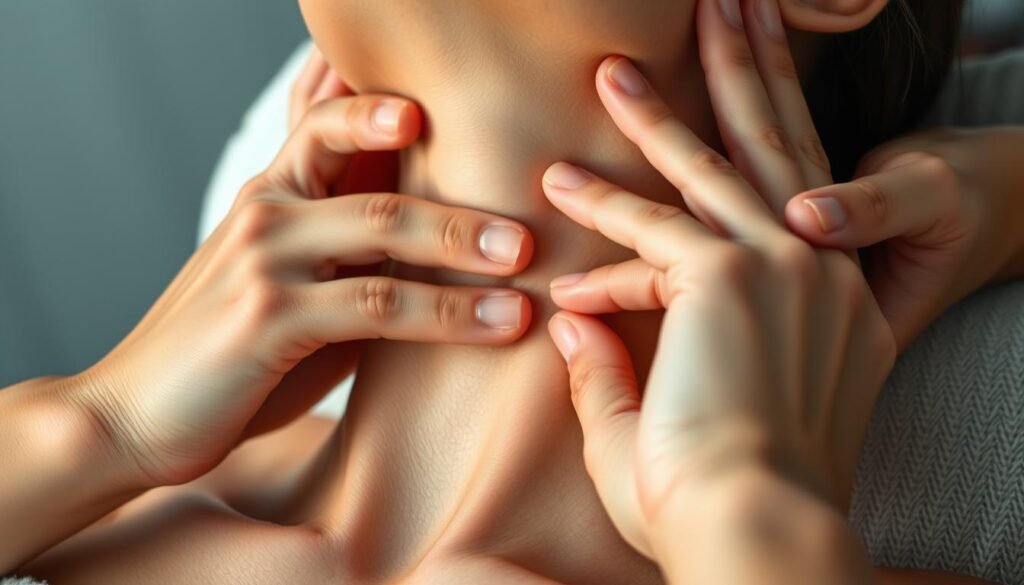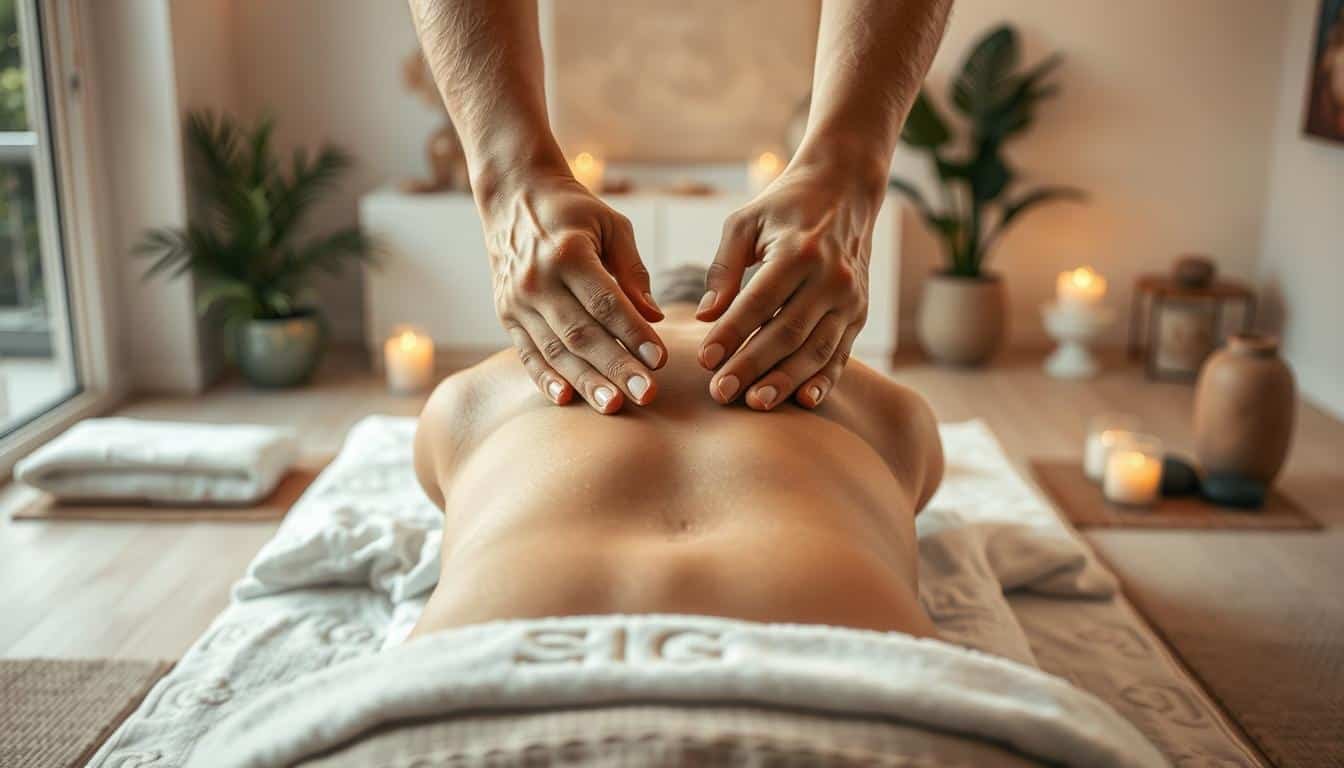Ever thought of bringing the spa to your home? Learning to give a home massage can turn your space into a relaxation haven. The massage industry is growing fast, expected to hit $124.5 billion by 2032. This shows how much people value massages for stress relief and wellness.
I’m excited to share simple steps for mastering relaxation massage. Whether it’s for your partner or yourself, this guide will teach you to create a calming massage at home.
We’ll cover everything from setting the mood to basic massage techniques. You’ll learn how to give a great home massage. Let’s explore the world of therapeutic touch and bring comfort and relaxation to those you care about.
Key Takeaways
- Home massages offer stress relief and promote wellness
- Basic massage techniques can be easily learned and applied
- Creating the right environment enhances the massage experience
- Effective communication is crucial during a massage session
- Proper use of oils and lotions can improve massage effectiveness
- Safety and precautions are important aspects of giving massages
Introduction to Home Massage Benefits
Home massage brings wellness right to your home. It has many benefits, like reducing stress and improving health. The power of touch is amazing.
Stress relief is a big plus of massage. After a long day, a massage is the best way to relax. It feels like a reset for your body and mind.
Regular massages also improve blood flow. This means more oxygen and nutrients for your body. It helps you recover faster and feel less sore after working out.
Massages can also strengthen relationships. Sharing this experience with a partner builds trust and deepens your bond. It’s a lovely way to show care and connect.
“The power of touch is healing and rejuvenating.”
Home massages help you care for yourself regularly. This practice has greatly improved my well-being. It’s key for managing stress and keeping a balanced life.
- Reduces muscle tension
- Enhances mood
- Improves sleep quality
- Boosts immune function
Embracing home massage has changed how I view health and relaxation. It’s a simple yet effective way to heal. Sometimes, the best healing comes from those closest to us.
Setting the Perfect Massage Environment

Creating the perfect massage environment is key for a relaxing experience. I’ll show you how to pick the right space, set a calming atmosphere, and prepare essential supplies.
Choosing the Right Space
Find a quiet spot in your home with few distractions. Make sure the room is at a comfortable temperature, between 68-72°F. A bedroom or spare room is often the best choice for a peaceful massage.
Creating a Relaxing Atmosphere
Use relaxation techniques to make the atmosphere better. Dim the lights or use candles for soft light. Play calming music or nature sounds to block out background noise. Aromatherapy with essential oils can also make the experience better.
Preparing Essential Supplies
Get all the massage supplies ready before you start. You’ll need:
- Massage oils or lotions
- Clean, comfortable sheets or blankets
- Pillows for support
- Towels to protect surfaces from oil
Put an old towel on your massage surface to avoid oil stains. Having everything ready makes the session smooth and uninterrupted.
| Essential Item | Purpose |
|---|---|
| Massage Oil | Reduces friction, moisturizes skin |
| Blankets | Keeps recipient warm, comfortable |
| Pillows | Provides support for body parts |
| Towels | Protects surfaces, cleans excess oil |
Understanding Basic Massage Techniques
Learning basic massage techniques is crucial for a good home massage. I’ll show you four key methods used in Swedish and deep tissue massage. These techniques are the base of most massage styles.
Effleurage: Gliding Strokes
Effleurage uses long strokes to warm muscles and relax them. I start with soft pressure and then get firmer. It’s great for starting a massage and spreading oil evenly.
Petrissage: Kneading Movements
Petrissage is a kneading method that eases muscle tension. I use my fingers and thumbs to gently lift and squeeze muscles. It’s perfect for working out knots in the shoulders and back.
Tapotement: Rhythmic Tapping
Tapotement involves quick, rhythmic tapping to stimulate the nervous system. I do this by cupping my hands and tapping lightly on the body. It boosts blood flow and can be refreshing at the end of a massage.
Friction: Circular Pressure
Friction applies circular pressure to break up adhesions and reduce inflammation. I use my fingertips or thumbs to make small, deep circles on specific spots. This method is often used in deep tissue massage to target problem areas.
| Technique | Primary Benefit | Best Used For |
|---|---|---|
| Effleurage | Relaxation | Warm-up, oil application |
| Petrissage | Tension relief | Knotted muscles |
| Tapotement | Stimulation | Increasing energy |
| Friction | Adhesion breakdown | Targeted problem areas |
How to Give a Home Massage: Step-by-Step Guide
I’m excited to share my step-by-step home massage guide with you. This self-massage routine is perfect for relaxation and tension relief. Let’s dive into the massage steps to create your own spa experience at home.
Start by having the recipient lie face down on a comfortable surface. Take a few deep breaths together to set a calm intention for the massage. Begin with the neck and shoulders, using gentle kneading motions to release tension.
Next, move to the back. Use your whole hand to apply pressure, keeping your back straight and utilizing your body weight. Work your way down the spine, paying extra attention to any tight areas.
- Shoulders and neck: Apply circular motions with your thumbs
- Upper back: Use long, sweeping strokes with your palms
- Lower back: Knead with your knuckles in small circles
- Arms and legs: Glide your hands from top to bottom
- Feet: Gently press your thumbs into the soles
Remember to maintain a steady rhythm throughout your home massage. This self-massage technique can be adapted for different body parts, making it a versatile addition to your relaxation routine.
“A good massage is like a mini-vacation for your body and mind.”
By following this home massage guide, you’ll be able to create a soothing experience for yourself or a loved one. Practice these massage steps regularly to improve your technique and enjoy the benefits of relaxation at home.
Massaging the Back: Techniques and Tips

Back massage techniques are key for relaxation and pain relief. I’ll show you how to give a soothing back massage. We’ll start at the shoulders and move down to the lower back.
Starting with the Shoulders
Start your shoulder massage at the neck’s base. Use your palms for gentle, circular motions on the shoulder blades. This eases tension in the upper back.
As you massage, increase pressure on any knots you find.
Working Down the Spine
For a great back massage, use alternating hand movements along the spine. Press with your thumbs on either side of the vertebrae, moving from top to bottom. This method eases muscle tightness and improves posture.
Addressing the Lower Back
Lower back massage needs extra care. Use your fingertips for small, circular motions on the lower back muscles. Mix light and deep pressure to target different tissue layers.
This helps reduce stiffness and boosts flexibility in the lumbar area.
| Area | Technique | Benefit |
|---|---|---|
| Shoulders | Circular motions | Releases upper back tension |
| Spine | Alternating hand movements | Alleviates muscle tightness |
| Lower Back | Fingertip circles | Reduces stiffness, improves flexibility |
Always talk to the person getting the massage to make sure they’re comfortable. Adjust the pressure as needed. With practice, you’ll get good at these back massage techniques. You’ll be able to give relaxing massages at home.
Effective Neck and Arm Massage Methods

Learning neck and arm massage techniques can really help relax your upper body. I’ve found these methods to be very effective in easing tension and improving well-being.
To start a soothing neck massage, I begin at the base of the skull. I use my fingertips to make small, gentle circles, moving downward. This helps release tight muscles and boosts circulation. Then, I move my hands under the upper back and up to the skull base, repeating this several times.
For an arm massage, I start at the wrist and move up to the shoulder. I apply gentle pressure with long, smooth strokes to relax the muscles. Afterward, I reverse direction, moving back down to the wrist. I usually do this 3-5 times on each arm for the best results.
“Regular neck and arm massages can significantly reduce stress and improve mobility, contributing to overall upper body relaxation.”
To get the most out of these techniques, create a calm environment and use quality massage oil. Always talk to your partner about the pressure and any discomfort. With practice, you’ll become skilled at these methods, bringing the spa experience into your home.
Leg and Foot Massage Techniques
Leg and foot massages are great for relaxation. I’ll show you some effective ways to ease tired legs and sore feet. These methods mix traditional massage with reflexology for a full experience.
Massaging the Thighs and Calves
Begin a leg massage at the ankles and move up. Use long strokes to warm the muscles. Then, apply gentle circular pressure on the thighs and calves. This boosts circulation and relieves tension.
- Knead the thighs with your palms and fingers
- Gently squeeze the calves to release tightness
- Use your thumbs to press along the shin area
Foot Reflexology Basics
Foot reflexology boosts overall health. Start by sliding your hands up and down the foot, applying gentle pressure. Focus on the sole, where many reflex points are found.
Key reflexology areas include:
| Foot Area | Corresponding Body Part |
|---|---|
| Ball of foot | Chest and lungs |
| Arch | Liver, pancreas, and kidney |
| Heel | Lower back and intestines |
Use your thumb to make small circles on these areas. For deeper pressure, form a loose fist and roll it across the foot’s sole. Always be gentle and listen to your body’s response during both leg and foot massage sessions.
Using Massage Oils and Lotions Effectively
Choosing the right massage oils and lotions is key for a relaxing massage. I’ll show you how to pick and use these products for a better home massage.
Choosing the Right Products
Think about your skin type and allergies when picking massage oils or lotions. Natural products are usually gentler. Always test a small amount on your wrist first to avoid any irritation.
- Grapeseed oil: Light and easily absorbed
- Jojoba oil: Mimics skin’s natural oils
- Coconut oil: Nourishing and moisturizing
Application Techniques
To use massage oils well, warm the bottle in hot water for a few minutes. This makes the oil spread smoothly and enhances the experience. Start by applying a small amount to your hands, then use smooth strokes to spread it on the skin.
| Product | Best For | Application Method |
|---|---|---|
| Massage Oils | Deep tissue massage | Gliding strokes |
| Massage Lotions | Swedish massage | Kneading movements |
| Natural Massage Products | Sensitive skin | Gentle circular motions |
Remember, a little goes a long way with massage oils and lotions. Start with a small amount and add more as needed. This ensures a comfortable and soothing massage.
Communication and Feedback During Massage
Effective massage communication is key to a successful home massage experience. I always start by asking about preferred pressure and areas that need extra attention. This sets the stage for a personalized session tailored to individual needs.
One of the best feedback techniques I use is the 1-10 scale for pressure. I aim for a 6-7, which most find comfortable. Throughout the massage, I check in regularly to ensure client comfort and make necessary adjustments.
Clear communication helps build trust and enhances the overall massage experience. I encourage my clients to speak up if they feel any discomfort or want changes in pressure or focus areas.
| Communication Aspect | Purpose | Example |
|---|---|---|
| Initial Discussion | Establish preferences | “What areas would you like me to focus on today?” |
| Pressure Scale | Gauge comfort level | “On a scale of 1-10, how’s the pressure?” |
| Regular Check-ins | Ensure ongoing comfort | “How are you feeling? Any adjustments needed?” |
| Encouraging Feedback | Promote open dialogue | “Please let me know if anything feels uncomfortable.” |
Remember, good massage communication is a two-way street. By fostering an environment of open dialogue, you’ll create a more relaxing and beneficial massage experience for your client.
Safety Considerations and Precautions
When giving a home massage, I always prioritize massage safety. It’s crucial to be aware of sensitive areas and potential risks. Let’s explore some key precautions to ensure a safe and enjoyable experience.
Avoiding Sensitive Areas
I’m careful around delicate spots like the spine, knee bones, and shins. These areas need gentle handling or may be best avoided altogether. I focus on muscles and soft tissues, steering clear of bony protrusions to prevent discomfort or injury.
Recognizing Contraindications
Massage precautions are vital for certain health conditions. I always ask about any injuries, illnesses, or recent surgeries before starting. Some contraindications might make massage unsafe, so it’s best to consult a doctor if unsure. Remember, proper hygiene is key – I use clean materials and wash my hands thoroughly.
After the massage, I remind recipients to stay hydrated and suggest a warm bath or shower. These simple steps help prolong the benefits and ensure a safe, relaxing experience. By following these guidelines, I can provide a soothing massage while keeping safety at the forefront.
FAQ
What are the benefits of giving a home massage?
How do I create the perfect massage environment?
What are the basic massage techniques?
How do I give an effective back massage?
What are some tips for massaging the neck and arms?
How can I give an effective leg and foot massage?
What types of massage oils or lotions should I use?
How can I ensure clear communication during the massage?
What safety considerations should I keep in mind?
Source Links
- How to Give a Full Body Massage: Step-by-Step Instructions – https://www.wikihow.com/Give-a-Full-Body-Massage
- 7 Tips For Giving A Perfect Massage From Experts – https://pressmodernmassage.com/blogs/going-deep/perfect-massage
- 5 Simple Steps to Massage Your Partner at Home – https://www.osmosis.com/blog/5-simple-steps-to-massage-your-partner-at-home/













10 Comments
Interesting read! But wouldnt the efficacy of a home massage largely depend on the persons skill level in massage techniques?
Guys, dont you think choosing the right massage oil is as crucial as setting the perfect environment? Just a random thought!
Absolutely! Massage oils can make or break the entire experience, no doubt about it!
Interesting read, but can we really achieve the same relaxation from a home massage as wed get from a professional one?
Isnt it better to have a professional do it? I mean, we cant really know all the pressure points, right?
Maybe, but learning and self-reliance will never go out of style. Trial and error, my friend!
Does anyone else think choosing the right space is just as crucial as the actual massage technique? Changes the whole vibe!
Interesting read! But isnt it crucial to discuss the type of oil to be used in home massages?
Im just wondering, does anyone have experience with using essential oils during home massages? Could they enhance relaxation?
Interesting read! But, wouldnt it be more beneficial if there was a section on different massage oils and their benefits? Just a thought!